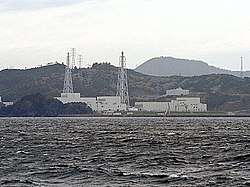Nuclear power station Photo Location Coordinates Status Units References Fukushima Daiichi Nuclear Power Plant Ōkuma 37°25′17″N 141°01′57″E / 37.42139°N 141.03250°E / 37.42139; 141.03250 (Fukushima I Nuclear Power Station ) Facility damaged beyond repair during the 2011 Great Tohoku Earthquake . 6 (all in decommissioning phase) [ 1] Fukushima Daini Nuclear Power Plant Naraha 37°19′10″N 141°01′16″E / 37.31944°N 141.02111°E / 37.31944; 141.02111 (Fukushima II Nuclear Power Station ) Facility rendered inoperable due to seawater deluge caused by the 2011 Great Tohoku Earthquake . 4 (all in decommissioning phase) [ 2] Genkai Nuclear Power Plant Genkai 33°30′56″N 129°50′14″E / 33.51556°N 129.83722°E / 33.51556; 129.83722 (Genkai Nuclear Power Station ) Units 3 and 4 in operation. Units 1 and 2 are permanently shut down. 4 (2 in decommissioning phase) [ 3] Hamaoka Nuclear Power Plant Omaezaki 34°37′25″N 138°08′33″E / 34.62361°N 138.14250°E / 34.62361; 138.14250 (Hamaoka Nuclear Power Station ) Facility indefinitely shut down due to unsafe seismic conditions. 5 [ 4] Higashidōri Nuclear Power Plant Higashidōri 41°11′17″N 141°23′25″E / 41.18806°N 141.39028°E / 41.18806; 141.39028 (Higashidōri Nuclear Power Station ) Facility currently shut down pending restart following the 2011 Great Tohoku Earthquake . 2 [ 5] Ikata Nuclear Power Plant Ikata 33°29′27″N 132°18′41″E / 33.49083°N 132.31139°E / 33.49083; 132.31139 (Ikata Nuclear Power Station ) Unit 3 in operation. 3 (1 in decommissioning phase) [ 6] [ 7] [ 8] Kashiwazaki-Kariwa Nuclear Power Plant Kashiwazaki 37°25′42″N 138°36′06″E / 37.42833°N 138.60167°E / 37.42833; 138.60167 (Kashiwazaki-Kariwa Nuclear Power Station ) Facility shut down pending restart. Units 6 and 7 are ready for restart however there is no specified solution for units 1-5. 7 (largest nuclear generating station in the world by net electrical power rating) [ 9] Mihama Nuclear Power Plant Mihama 35°42′09″N 135°57′48″E / 35.70250°N 135.96333°E / 35.70250; 135.96333 (Mihama Nuclear Power Station ) Unit 3 in operation 3 [ 10] Ōi Nuclear Power Plant Ōi 35°32′26″N 135°39′07″E / 35.54056°N 135.65194°E / 35.54056; 135.65194 (Ōi Nuclear Power Station ) Units 3 and 4 are in operation. Units 1 and 2 are permanently shut down. 4 (2 in decommissioning phase) [ 11] Onagawa Nuclear Power Plant Onagawa 38°24′04″N 141°29′59″E / 38.40111°N 141.49972°E / 38.40111; 141.49972 (Onagawa Nuclear Power Station ) Unit 2 in operation. 3 [ 12] Sendai Nuclear Power Plant Satsumasendai 31°50′01″N 130°11′23″E / 31.83361°N 130.18972°E / 31.83361; 130.18972 (Sendai Nuclear Power Station ) All units are in operation. 2 [ 13] Shika Nuclear Power Plant Shika 37°03′40″N 136°43′35″E / 37.06111°N 136.72639°E / 37.06111; 136.72639 (Shika Nuclear Power Station ) Plant under consideration for decommissioning due to the presence of fault lines underneath the reactors. 2 [ 14] Shimane Nuclear Power Plant Matsue 35°32′18″N 132°59′57″E / 35.53833°N 132.99917°E / 35.53833; 132.99917 (Shimane Nuclear Power Station ) Facility currently shut down pending restart following the 2011 Great Tohoku Earthquake , construction on unit 3 halted. 3 [ 15] Takahama Nuclear Power Plant Takahama 35°31′20″N 135°30′17″E / 35.52222°N 135.50472°E / 35.52222; 135.50472 (Takahama Nuclear Power Station ) Units 1, 3, and 4 are in operation. Unit 2 was restarted September 15, 2023, and plans to restart commercial operations in October 2023. 4 [ 16] [ 17] [ 18] Tōkai Nuclear Power Plant Tōkai 36°27′59″N 140°36′24″E / 36.46639°N 140.60667°E / 36.46639; 140.60667 (Tōkai Nuclear Power Station ) The facility has been decommissioned. The oldest nuclear power plant in Japan. 2 (1 decommissioned, 1 shut down) [ 19] Tomari Nuclear Power Plant Tomari , Shiribeshi Subprefecture 43°02′10″N 140°30′45″E / 43.03611°N 140.51250°E / 43.03611; 140.51250 (Tomari Nuclear Power Station ) Facility currently shut down pending restart following the 2011 Great Tohoku Earthquake . 3 [ 20] Tsuruga Nuclear Power Plant Tsuruga 35°40′22″N 136°04′38″E / 35.67278°N 136.07722°E / 35.67278; 136.07722 (Tsuruga Nuclear Power Station ) Due to seismic conditions the plant remains shut down following the 2011 Great Tohoku Earthquake . 2 (1 decommissioned, 2 under construction) [ 21] [ 22] [ 23] [ 24] 















